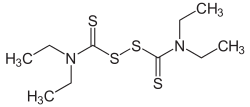| Disulfiram-like drug | |
|---|---|
| Drug class | |
 Disulfiram, the prototypical drug of this class. | |
| Class identifiers | |
| Synonyms | Alcohol sensitizers; alcohol-sensitizing agents; alcohol-deterrent drugs; acetaldehyde dehydrogenase inhibitors |
| Use | Alcoholism |
| Biological target | Acetaldehyde dehydrogenase, others |
| Legal status | |
| In Wikidata | |
A disulfiram-like drug is a drug that causes an adverse reaction to alcohol leading to nausea, vomiting, flushing, dizziness, throbbing headache, chest and abdominal discomfort, and general hangover-like symptoms among others. [1] [2] These effects are caused by accumulation of acetaldehyde, a major but toxic metabolite of alcohol formed by the enzyme alcohol dehydrogenase. [1] [2] The reaction has been variously termed a disulfiram-like reaction , alcohol intolerance, and acetaldehyde syndrome. [3]
Contents
- List of agents
- Intended
- Unintended
- Natural
- List of agents previously thought to cause disulfiram-like reactions
- Dopaminergic neurotoxicity
- See also
- References
- External links
The prototypical drug of this group is disulfiram (brand name Antabuse), which acts as an acetaldehyde dehydrogenase inhibitor, preventing the metabolism of acetaldehyde into acetic acid, and is used in the treatment of alcoholism. [1] [2] A variety of other drugs cause disulfiram-like reactions upon consumption of alcohol as unintended drug interactions and side effects. [1] [2] Many disulfiram-like drugs act as inhibitors of acetaldehyde dehydrogenase similarly to disulfiram. However, some do not act via inhibition of this enzyme, and instead act via other, poorly elucidated mechanisms.
Unlike acetaldehyde dehydrogenase inhibitors and other disulfiram-like drugs, alcohol dehydrogenase inhibitors such as fomepizole (brand name Antizol) inhibit the metabolism of alcohol into acetaldehyde, thereby increasing and extending the effects of alcohol and reducing its toxicity. [4] As such, they can be thought of as converses of disulfiram-like drugs. [4] Fomepizole is used medically as an antidote against methanol and ethylene glycol poisoning. [4]